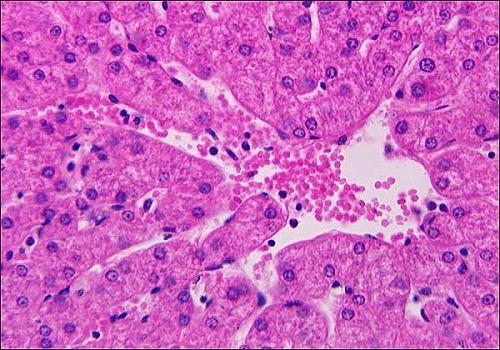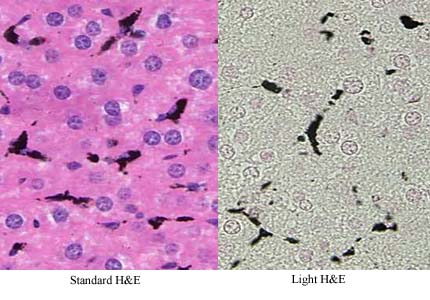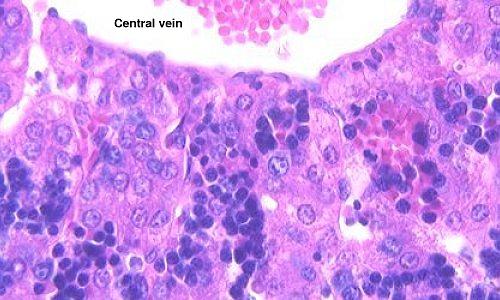VIVO Pathophysiology
Hepatic Histology: Sinusoids
Sinusoids are low pressure vascular channels that receive blood from terminal branches of the hepatic artery and portal vein at the periphery of lobules and deliver it into central veins. Sinusoids are lined with endothelial cells and flanked by plates of hepatocytes.
The image below shows the center of a lobule in porcine liver (H&E stain). Notice several sinusoids opening into the central vein (pass your mouse cursor over the image for labels).

The space between sinusoidal endothelium and hepatocytes is called the space of Disse. Sinusoidal endothelial cells are highly fenestrated, which allows virtually unimpeded flow of plasma from sinusoidal blood into the space of Disse. This arrangement has at least two important consequences:
- Hepatocytes are bathed in plasma derived in large part from venous blood returning from the small intestine. Following meals, that plasma is nutrient-rich.
- Plasma which collects in the space of Disse flows back toward the portal tracts, collecting in lymphatic vessels and forming a large fraction of the body's lymph.
Another important feature of hepatic sinusoids is that they house an important part of the phagocytic system. Sinusoids are populated by numerous Kupffer cells, a type of fixed macrophage. Identifying Kupffer cells in conventionally-stained sections of liver is not easy. However, they stand out sharply when full of phagocytosed ink particles.
The images below are of a mouse liver fixed two hours after an intravenous injection of a small quantity of India ink, which provides a clear view of these tiny warriors. All of the black masses are ink-laden Kupffer cells lying in sinusoids.

As a final point of interest, examine the following micrograph of ovine liver (H&E stain). The sinusoids are packed with clusters of basophilic cells that have not been seen in previous micrographs of liver - what are they?

This section of liver was taken from a 100 day sheep fetus. The clusters of cells in sinusoids are various types of immature blood cells. In the fetus, the liver is a major site of hematopoiesis, or formation of blood cells. Hepatic hematopoiesis is not normally seen after birth, although it can occur under certain pathologic conditions.
Back to: Liver Histology: Introduction and Index ^
Send comments to Richard.Bowen@colostate.edu